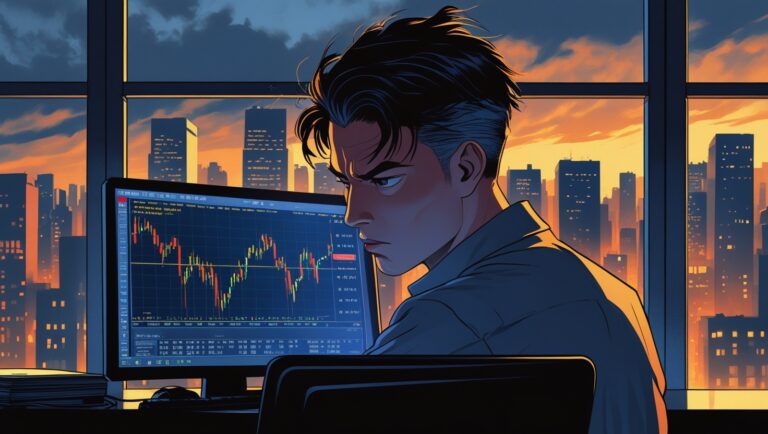What I Learned Watching Charts for Hours (And Why I Stopped)
What I Learned Watching Charts for Hours (And Why I Stopped)
When I first started trading, I thought the secret to success was watching charts all day. I believed if I just stared long enough, I’d magically understand the market. I’d sit at my desk, eyes glued to my screen, tracking every tick like my life depended on it. But here’s what really happened — I got burned out and confused.
The longer I watched, the more I second-guessed my trades. I’d find myself jumping in too early, exiting too late, or overtrading because I thought I “saw something.” In reality, I was just chasing noise, not setups.

Table of Contents
My Turning Point
Eventually, I asked myself: Is this really working? Was all that screen time making me profitable — or just tired?
The truth hit me hard. I wasn’t getting better by watching more. I was reacting more, stressing more, and losing more. That’s when I knew I had to change my approach.
I Stopped Watching, Started Planning
I made a bold move — I stopped watching charts for hours and instead started building a routine. Every morning before the market opens, I prepare a tight watchlist. I define my key levels. I map out my ideal entries and exits.
Now, I only need to be focused during the key moments — usually the first 30 minutes of the market. The rest? I step away. I don’t babysit my trades. I let them work.
My Results Improved Instantly
The crazy part? Once I stopped staring at every tick, my performance improved. I became more selective, more patient, and more confident. I wasn’t overwhelmed by noise. I had clarity.
My wins became cleaner. My losses were smaller. And most importantly, I wasn’t glued to my screen all day — I had my life back.
What You Can Do Instead
If you’re still watching charts all day hoping to become a better trader, I’m here to tell you: there’s a better way.
You need structure, not screen time. You need a plan, not panic. You need a system that fits your life — not one that takes over your life.
That’s exactly what I share in my ebook. I break down how I pay my bills with simple setups, even with a small account — and without watching charts all day.
Final Thoughts: Less is More
The idea that “more effort = more profit” doesn’t apply in trading. More discipline = more profit.
If you build a clean system and trust it, you don’t need to stare at charts for hours. You’ll know when to enter, when to wait, and when to walk away — and that’s what separates real traders from stressed-out gamblers.
If I could go back and do one thing differently from day one?
I would’ve spent less time watching and more time preparing.
One big realization I had was that charts can trick your emotions. The more you watch the candles move, the more you start to imagine trades that aren’t there. I’d see a green candle and feel FOMO. I’d see a pullback and panic. But when I stepped back and let the chart come to me, my decision-making changed completely.
Instead of reacting to every move, I now focus on price levels I already marked during pre-market. That way, when the price reaches my zone, I’m ready — not guessing. I act on a plan, not a feeling. That one change helped me cut a ton of unnecessary losses.
Watching charts all day also made me overcomplicate simple setups. I’d overthink every entry, second-guess my system, and start tweaking things that didn’t need to be changed. Trading stopped feeling strategic and started to feel chaotic.
The truth is, trading should be boring. I know that sounds strange, but the best trades aren’t exciting — they’re just clean, well-planned setups that play out over and over. The excitement comes from the results, not the noise.
That’s exactly the kind of structure I share in my trading ebook. I walk through how I prepare in the morning, how I build my watchlist, and how I avoid overtrading — all without relying on indicators or alerts.
Once I stopped watching charts all day, I had more energy to review my past trades. That gave me deeper insights into my strengths and weaknesses. Reviewing trades taught me more than staring at live price action ever did.
I also started using my time to journal each trade. I’d write down why I took it, how it went, and what I’d do differently. That habit made me a sharper trader, faster.
And because I wasn’t glued to the screen anymore, I actually felt less stress and more confidence. I wasn’t burned out by 11AM. I could step away, live my life, and trust my system to do the heavy lifting.
A few friends in my community still sit in front of charts all day, and they wonder why they aren’t improving. I always tell them — you don’t need more screen time, you need a better plan. That’s what separates consistent traders from frustrated ones.
The market rewards discipline — not hustle. It’s not about how long you stare at the candles. It’s about whether your trade idea is clear, valid, and well-managed.
Now, I usually trade in the first 15–30 minutes, and sometimes I’m done for the day by 10AM. I used to think I needed to be “working” all day to deserve the money. But trading isn’t about hours logged — it’s about decisions made.
If you’re new and want a shortcut to what really works — the kind that helped me finally become profitable — grab my ebook. It’s built for small accounts, busy people, and those tired of information overload.
👉 Download it here
One of the most underrated things I did was step away and zoom out. Instead of watching every tick on the 1-minute chart, I started analyzing the big picture — daily levels, volume trends, and market sentiment. That shift gave me context and stopped me from getting shaken out by tiny price moves.
I also noticed that the more I watched, the more I hesitated. It sounds backwards, but staring at the chart too long made me second-guess my entries. I’d miss perfect setups because I was overanalyzing instead of just executing what I already planned before the bell.
Lastly, by cutting back on screen time, I found space to build my own edge. I wasn’t just copying others or reacting to chat rooms. I had the mental clarity to refine my process — and that’s when I truly started growing as a trader. My strategy became mine, not someone else’s.

Stay ahead in the stock market! Subscribe to our newsletter and receive exclusive stock flow reports, trading insights, and actionable tips directly in your inbox. Join thousands of traders who get our updates first.







